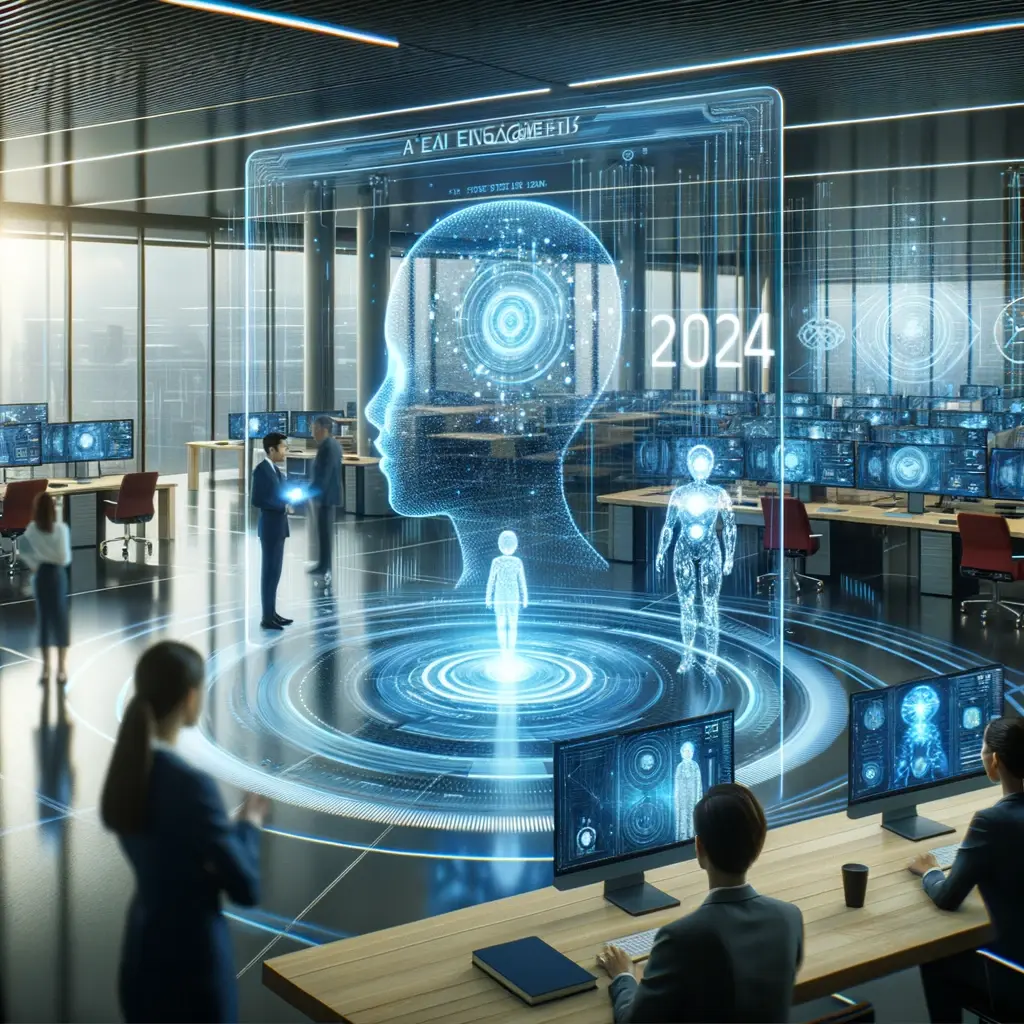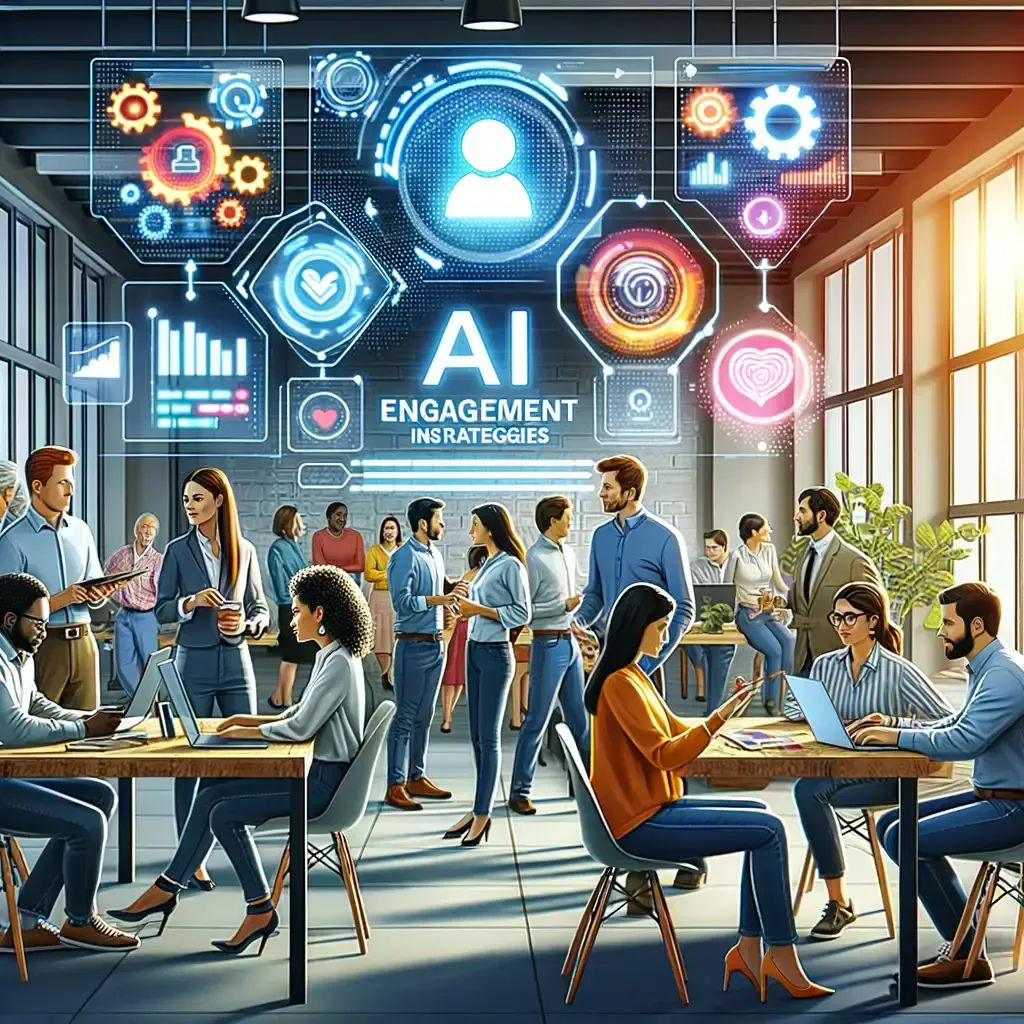Table of Contents
The dynamic nature of the corporate realm has always been characterized by its adaptability and responsiveness. As we navigate through the complexities of the 21st century, technological advancements like artificial intelligence (AI) are emerging as game-changers in various sectors, particularly in the sphere of employee engagement.
The term “employee engagement” traditionally revolved around human-centric approaches, from team-building exercises to feedback mechanisms. However, as the digital revolution accelerates, AI is becoming an indispensable tool in reimagining and enhancing these strategies.
AI Employee Engagement Strategies harness the power of advanced algorithms, data analytics, and machine learning to provide insights that were previously inaccessible. These strategies are not just about automating tasks or analyzing vast amounts of data. They are about understanding the individual needs, aspirations, and potential pain points of each employee. By doing so, companies can tailor their engagement efforts in a way that resonates with every team member, ensuring not just productivity but also well-being.
For instance, imagine a system that can predict when an employee might be feeling overwhelmed and then suggest proactive measures to the management. Or a platform that customizes training modules based on the unique learning style and career aspirations of each employee. These are just glimpses of what AI Employee Engagement Strategies can offer.
For organizations aiming to stay at the forefront of AI-driven employee engagement, exploring platforms specialized in creating bespoke AI companions for staff is essential. An exemplary model is Lindy.ai, offering a pioneering solution that personalizes the employee experience by leveraging AI-driven interactions. This innovative approach underpins high-touch engagement strategies, exemplifying how technology can vastly enhance company culture and cohesion.

1. AI Employee Engagement Strategies using Predictive Analytics
What it is: Predictive analytics, fortified by AI Employee Engagement Strategies, used for historical data to identify and forecast future employee trends and behaviors. Such foresight allows companies to anticipate challenges, identify opportunities, and create more responsive, dynamic workplaces.
Example: A fresh addition to the market is “TrendSpotter,” which debuted in late 2023. This AI-powered tool specializes in assessing employee satisfaction and potential retention risks.
By analyzing communication patterns, project engagement levels, and even digital body language from video meetings, “TrendSpotter” can predict which teams or individuals might be feeling disengaged or considering leaving the company.
For instance, if the tool identifies a decline in participation from a usually active team member during brainstorming sessions or detects increased levels of passive communication, it can alert management to potential engagement issues, prompting timely interventions.
TrendSpotter can assess factors like an employee’s attention span during meetings, frequency of participation, or even subtle cues like facial expressions and posture to gauge engagement levels.
2. AI Employee Engagement Strategies for Personalized Learning and Development:
What it is: Rather than one-size-fits-all training modules, AI-driven platforms are now curating personalized learning paths that align with an employee’s career trajectory, skill set, and aspirations, thereby ensuring more effective and engaging professional development.
Example: At HealthFirst, a healthcare provider, nurses often juggle varying schedules and patient loads. Using AI, the company can analyze each nurse’s workload, preferences, and past feedback to create a personalized work schedule. This not only ensures optimal patient care but also significantly boosts the nurses’ job satisfaction.
With fluctuating patient loads, varying shift requirements, and the intrinsic demands of the profession, nurses were often stretched thin, leading to potential burnout and decreased job satisfaction.
HealthFirst stands as a beacon, illuminating the path forward with AI at its helm.
3. AI Employee Engagement Strategies for Feedback Mechanisms:
What it is: Feedback is pivotal for growth. AI Employee Engagement Strategies used for enhanced feedback mechanisms don’t just collect feedback; they analyze, categorize, and even prioritize it, ensuring that companies can act on it in meaningful, timely ways.
Example: GlobalFin, a finance firm, employs an AI system that periodically collects feedback from its employees through surveys and direct inputs. The system then analyzes this data, highlighting areas of concern or opportunities for improvement.
For instance, if multiple employees mention a lack of advanced Excel training, the system can automatically schedule a workshop addressing this need.
Employees at GlobalFin are periodically prompted by the AI system to provide feedback through comprehensive surveys and direct input channels.
4. AI Employee Engagement Strategies for Collaborative Workspaces:
What it is: Collaboration is central to innovation. AI Employee Engagement strategies take collaborative workspaces a notch higher by streamlining communication, suggesting optimal team combinations based on strengths, and even predicting potential project roadblocks.
Example: Fantasy AI, a digital design agency, uses an AI-integrated workspace where team members can collaborate on projects. The system can suggest design changes in real-time, schedule brainstorming sessions based on team members’ availability, and even prioritize tasks based on deadlines and individual workloads.
The AI’s capability doesn’t stop there. It can seamlessly schedule brainstorming sessions, factoring in each team member’s availability, and ensuring that everyone can contribute without feeling overburdened.
By analyzing project scopes, client deadlines, and individual workloads, it efficiently allocates tasks, ensuring timely delivery without compromising on quality.
In the competitive world of digital design, tools like Fantasy AI are proving to be game-changers, enabling agencies like DesignHub to consistently deliver top-tier work while fostering a collaborative and efficient work environment.
5. AI Employee Engagement Strategies for Wellness Programs:
What it is: Employee well-being is directly linked to productivity and loyalty. AI Employee Engagement strategies for wellness programs provide tailored wellness solutions, monitor mental health, and offer proactive interventions, ensuring a holistic approach to employee health.
Example: “TotalWell AI” stands out as a beacon in the realm of employee wellness. Launched in 2023, this platform offers a 360-degree wellness solution. Employees can interact with TotalWell to set personalized health goals, get nutritional advice tailored to their needs, access guided meditation sessions, and even seek counseling or therapy resources.
By analyzing an employee’s work patterns, stress indicators, and self-reported data, TotalWell can proactively suggest interventions. For instance, if an employee frequently works late hours, TotalWell might prompt them to take regular screen breaks and engage in short relaxation exercises.
For instance, if an employee frequently works late hours, TotalWell might prompt them to take regular screen breaks and engage in short relaxation exercises.
This proactive approach ensures that potential burnout or stress can be addressed before it escalates, fostering a work environment where employees feel genuinely cared for.

Case Study: TechFusion Corp
Background: TechFusion Corp, a mid-sized tech company, was facing a challenge. Despite competitive salaries and benefits, employee turnover was high, and engagement scores were consistently below the industry average. Determined to revamp their employee experience, they turned to AI Employee Engagement Strategies in 2023.
Implementation:
- Predictive Analytics: Using an AI tool named “FutureSight,” TechFusion began analyzing patterns in employee behavior, feedback, and performance. The tool identified that newer employees felt lost during their initial months, leading to early turnover.
- Personalized Learning: To address the onboarding challenge, TechFusion introduced “AdaptLearn,” an AI-driven platform that created customized onboarding paths, catering to the specific role, department, and even individual preferences of new hires.
- Feedback Mechanisms: “EchoNest” was introduced, an AI-driven feedback tool that not only collated feedback but also analyzed it to identify recurring themes. One such theme was the lack of advanced training opportunities for mid-level managers.
- AI-Powered Collaboration: To boost inter-departmental projects, “TeamSync AI” was introduced. This tool would recommend project teams based on individual strengths and past collaboration successes.
- Wellness Initiatives: Recognizing the increasing stress levels in their workforce, TechFusion introduced “WellGuard AI,” a virtual wellness assistant that provided personalized wellness challenges, relaxation techniques, and mental health resources.
Outcome: A year into the implementation of these strategies, TechFusion saw a 25% reduction in employee turnover. Engagement scores shot up by 40%, and there was a palpable improvement in inter-departmental collaborations. The mid-level managers, after undergoing advanced training modules suggested by EchoNest, showcased a 30% improvement in project delivery and leadership metrics.
Case Study: GreenTech Innovations
Background: GreenTech Innovations, a leading player in sustainable technology solutions, was witnessing a plateau in innovation despite having some of the brightest minds in the industry.
Implementation:
- Predictive Analytics: GreenTech employed “InnoSight AI” to analyze patterns of collaboration and ideation in the company. The AI highlighted a pattern of siloed working, where departments rarely collaborated on projects.
- Personalized Learning: “SkillMap AI” was introduced, an adaptive learning tool that not only identified skill gaps in teams but also recommended cross-functional training sessions.
- Feedback Mechanisms: “InsightSphere” was adopted to gather continuous feedback on project outcomes, challenges faced, and areas of improvement.
- AI-Powered Collaboration: “CollabMax AI” was rolled out to suggest potential cross-departmental projects based on the company’s innovation goals and individual team strengths.
- Wellness Initiatives: To address rising stress, especially among their R&D teams, GreenTech introduced “SerenityAI,” offering personalized mental health resources and resilience-building challenges.
Outcome: Post-implementation, GreenTech saw a 60% increase in cross-departmental projects. More importantly, their product innovation cycle was reduced by 30%, leading to faster, more sustainable tech solutions reaching the market.
Conclusion
The integration of AI Engagement Strategies in the workplace is not a mere trend; it’s an evolution. As we approach 2024, companies that embrace these strategies will not only enhance productivity but also foster a workplace where employees feel valued, understood, and engaged.
By leveraging AI’s immense potential, businesses can create dynamic, responsive, and nurturing work environments that are equipped to meet the challenges of the future. The blend of AI and human intelligence promises a harmonious synergy, propelling organizations toward unprecedented growth and success.
The transformative tales of TechFusion Corp and EduFutures Academy underscore the potential of AI Employee Engagement Strategies. As 2024 looms on the horizon, AI’s fusion with human-centric approaches promises workplaces and institutions that are not just efficient but also deeply attuned to individual needs and aspirations.
Embracing this AI-driven wave is the key to nurturing environments where every individual feels truly valued, engaged, and empowered to reach their fullest potential.